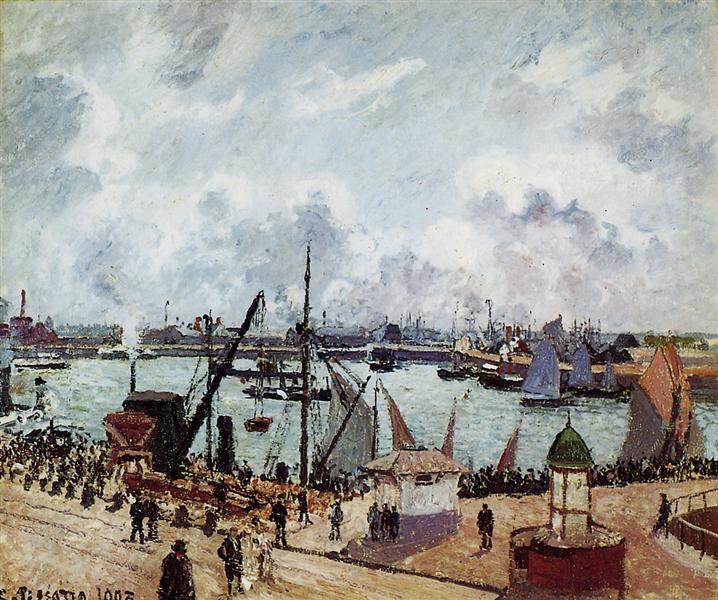विवरण
Camille Pissarro's 1903 painting "The Outer Harbor of Le Havre" stands as a brilliant example of the Impressionist style that defined not only the artist's career but also an era in the evolution of art. A master at capturing light and movement, Pissarro employs a rich, vivid palette to portray the vibrant activity of the harbor, offering the viewer a window into the daytime life of this crucial hub of trade and transportation.
Looking at the composition, it is clear that Pissarro is using a balance that is typical of Impressionism. The arrangement of the boats in the water, together with the architecture of the dock and the factories in the background, are intertwined in such a way that the scene seems to breathe. This dynamism is achieved through the loose brushwork and varied texture that characterizes his work, allowing the light to reflect off the surface of the water and the hulls of the boats. Pissarro fragments the light into bright, vibrant colors, using a mixture of blue, green and gray tones that, together with the warm touches of the buildings, create a harmony that evokes both calm and activity.
The characters in "Outer Harbor of Le Havre" seem to be absent. Rather than focusing attention on individual human beings, Pissarro emphasizes the relationship between nature and industrial activity, allowing the environment to become the true protagonist. This approach could be interpreted as a commentary on modern life, the relationship of humans with their creations and nature, a recurring theme in Pissarro's work. Nevertheless, some figures are hinted at in the distance, alluding to the daily life of the port without stealing the spotlight from the scene as a whole.
Something notable about this work is the way Pissarro uses the technique of the split-colour system, where hues are applied in small dabs, creating an optical blend that transforms the surface into a tide of hues. This technique not only highlights the shimmer of the water, but also suggests the ceaseless movement of the harbour. Looking closely, one can appreciate how light is summoned by the juxtaposition of colours, something Pissarro mastered throughout his career.
Pissarro's interest in urban environments and its evolution throughout his career is palpably reflected in this work, which is set in a period when Impressionism sought to move away from crude allusions to reality, opting instead for a more subtle and contemplative approach. "Outer Harbor of Le Havre" encapsulates this transition, showing a busy harbor but distancing it from the direct representation of frenetic urban life.
This work can be contextualized within the evolution of Impressionism in the early twentieth century, where artists such as Claude Monet and Pierre-Auguste Renoir were also exploring maritime and urban themes. Thematic and technical similarities offer a compelling comparative history, establishing Pissarro not only as a participant in the movement, but as a singular and necessary voice.
In conclusion, “Outer Harbor of Le Havre” is a testament not only to Camille Pissarro’s technical mastery, but also to his ability to encapsulate the essence of his surroundings. The viewer is invited to immerse themselves in the harbor’s atmosphere, transcending mere visual representation into a dynamic experience, captured through light and color. This canvas not only tells us about the place, but becomes a dialogue about the interaction between humans, their environment, and the inevitable passage of time.
KUADROS ©, a famous painting on your wall.
Hand-made oil painting reproductions, with the quality of professional artists and the distinctive seal of KUADROS ©.
Painting reproduction service with satisfaction guarantee. If you are not completely satisfied with the replica of your painting, we will refund 100% of your money.

